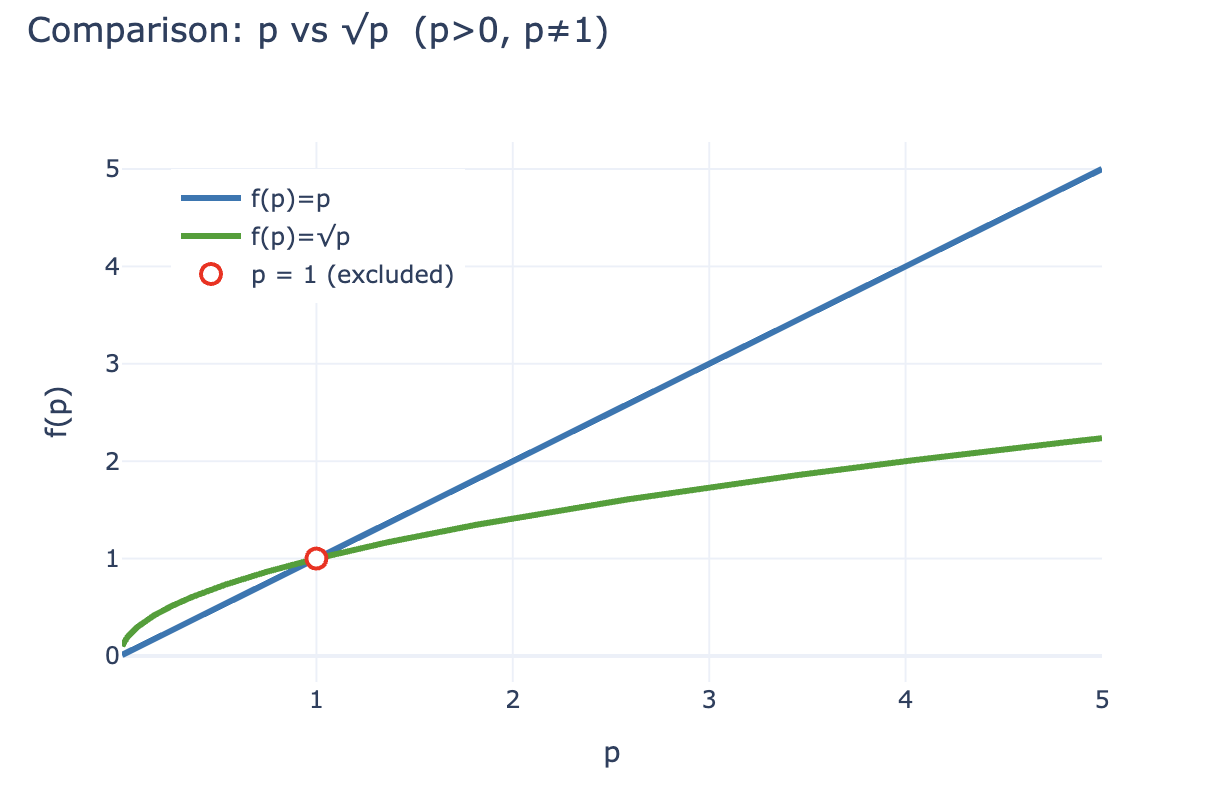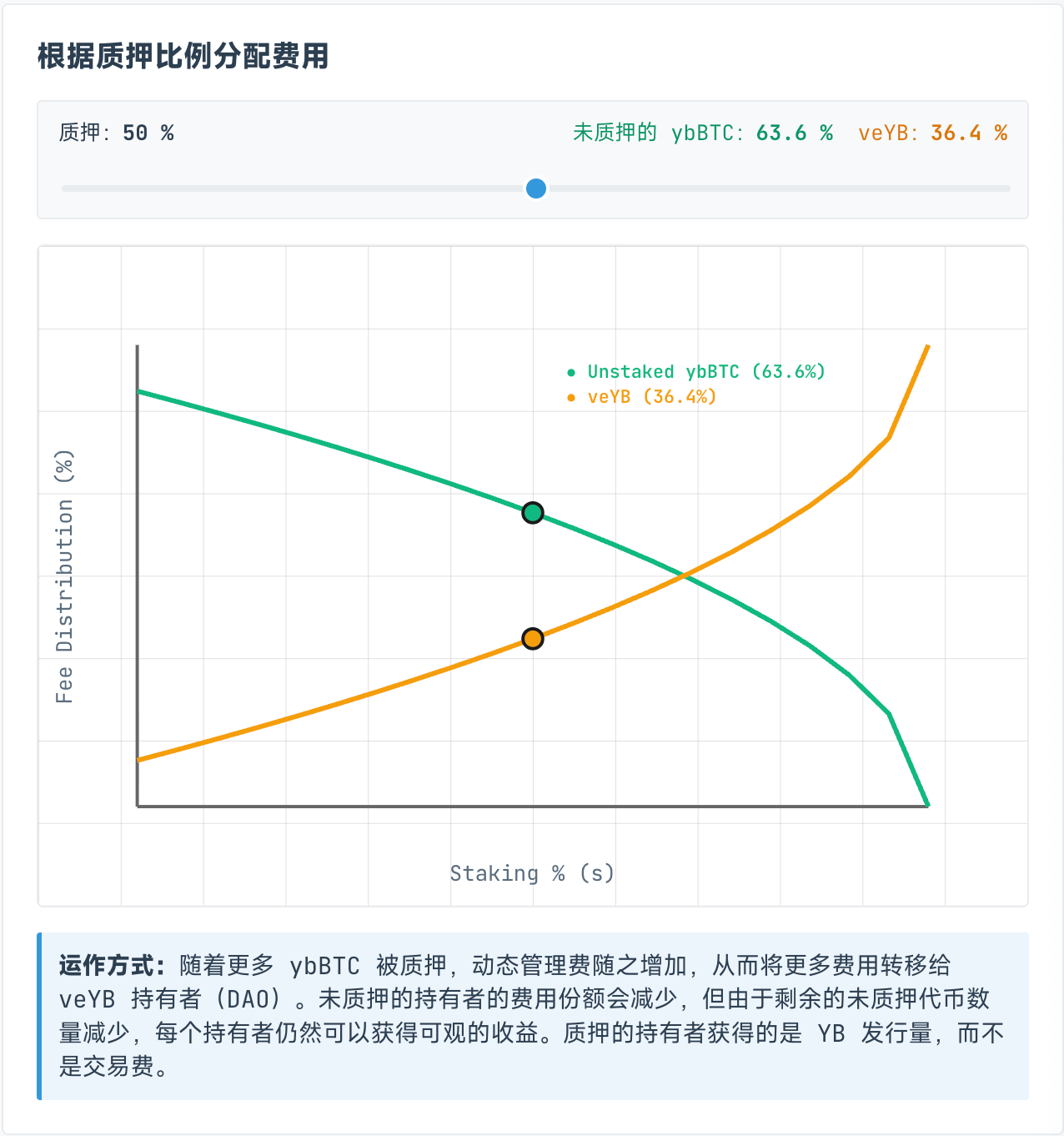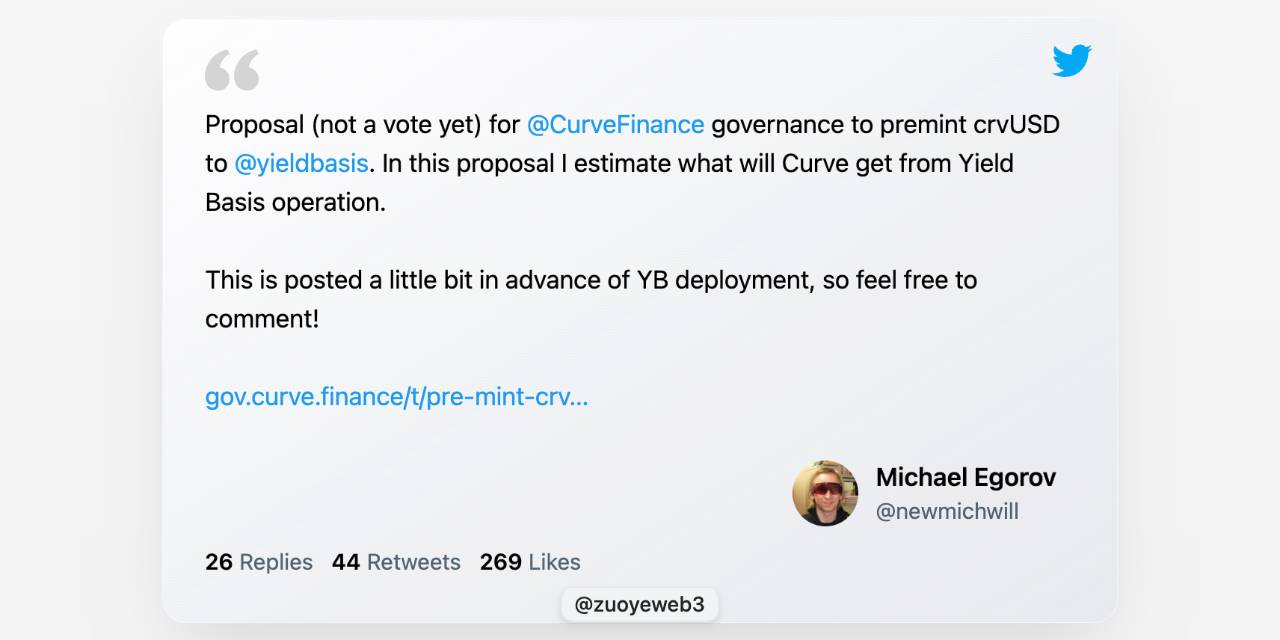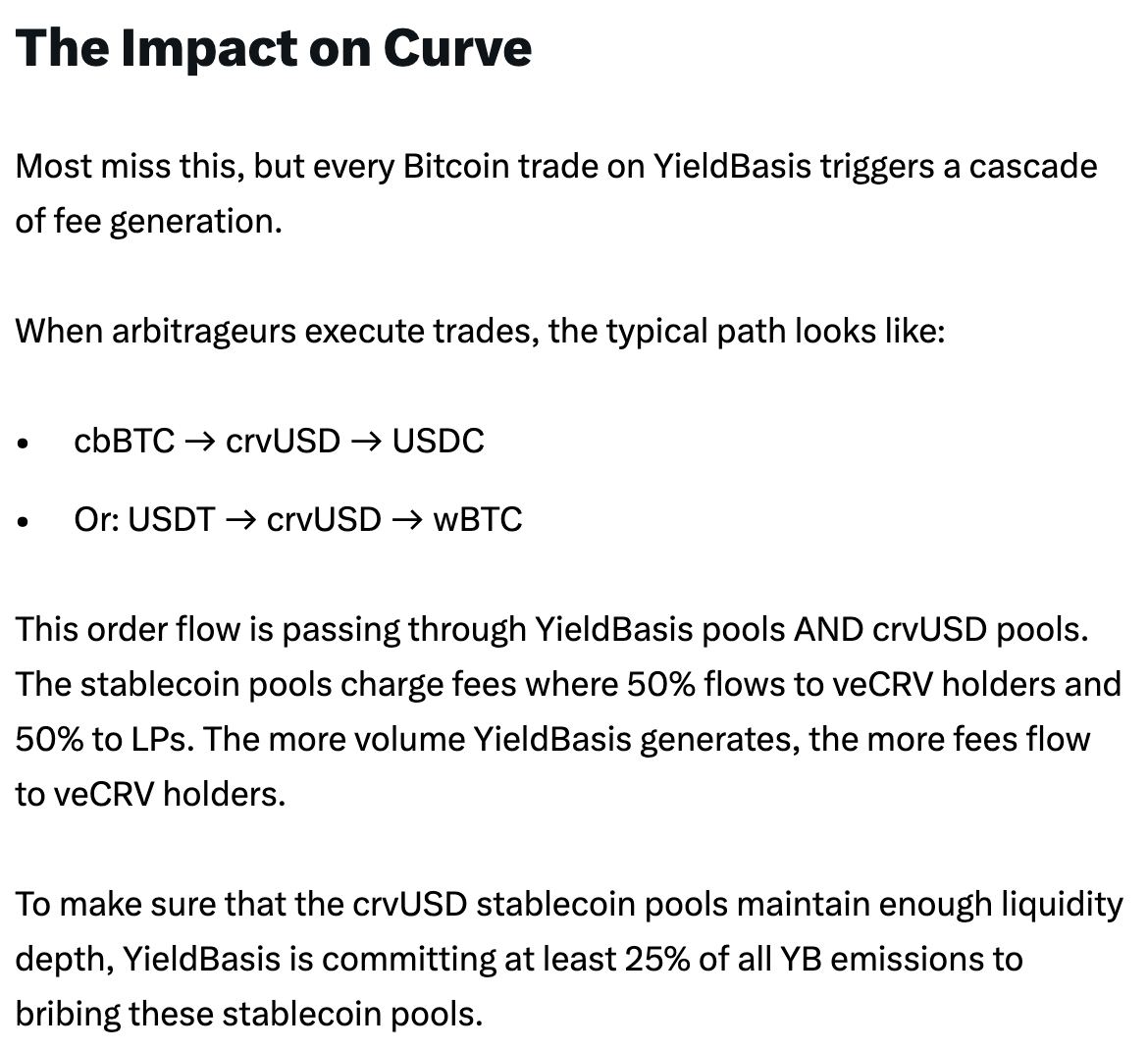The Expansion Path of Stablecoin Trading Beyond Ethena
Author: Zuo Ye, Crooked Neck Mountain
After the collapse of Luna-UST, stablecoins completely bid farewell to the era of stability. The CDP mechanism (DAI, GHO, crvUSD) once became the hope of the entire village, but ultimately, it was Ethena and the yield anchoring paradigm it represents that broke through the encirclement of USDT/USDC. This approach not only avoids the inefficiency of over-collateralization but also leverages native yield characteristics to open up the DeFi market.
In contrast, the Curve ecosystem, after relying on stablecoin trading to open up the DEX market, gradually ventured into the lending market with Llama Lend and the stablecoin market with crvUSD. However, under the brilliance of the Aave ecosystem, the issuance of crvUSD has long hovered around 100 million dollars, essentially relegating it to the background.
However, after the flywheel of Ethena/Aave/Pendle was set in motion, Curve's new project Yield Basis also aimed to take a slice of the stablecoin market pie, starting with circular leveraged lending, but this time focusing on trading, hoping to eliminate the chronic issue of impermanent loss (IL) in AMM DEX.
Eliminating Impermanent Loss through Unilateralism
Curve's latest masterpiece, now your BTC is mine, hold onto your YB and stand guard.
Yield Basis represents a renaissance; in one project, you can see liquidity mining, pre-mining, Curve War, staking, veToken, LP Token, and circular lending, making it a culmination of DeFi development.
Curve founder Michael Egorov was an early beneficiary of DEX development, improving upon Uniswap's classic AMM algorithm x*y=k, and successively launching stableswap and cryptoswap algorithms to support more "stablecoin trading" and a more efficient universal algorithm.
The large-scale trading of stablecoins established Curve's position in the early on-chain "borrowing" market for USDC/USDT/DAI, making Curve the most important on-chain infrastructure for stablecoins before the Pendle era. The collapse of UST was also directly linked to the moment of liquidity withdrawal from Curve.
In terms of token economics, the veToken model and the subsequent "bribery" mechanism Convex made veCRV a truly functional asset. However, after a four-year lock-up period, most $CRV holders have their own grievances that are not for outsiders to know.
With the rise of Pendle and Ethena, the market position of the Curve ecosystem is no longer secure. The core issue for USDe is that hedging comes from CEX contracts, diverting traffic to use sUSDe to capture yields, making the importance of stablecoin trading itself less significant.
The Curve ecosystem's counterattack first came from Resupply, which, in 2024, launched in collaboration with the two early giants Convex and Yearn Fi, but unsurprisingly faced a blowout, marking Curve's first failed attempt.
Although Resupply was not an official Curve project, it broke the bones and connected the tendons. If Curve did not counterattack again, it would be difficult to buy a ticket to the future in the new era of stablecoins.
When an expert takes action, it is indeed different. Yield Basis does not target stablecoins or the lending market but rather the issue of impermanent loss in AMM DEX. However, it should be stated: The true purpose of Yield Basis has never been to eliminate impermanent loss but to promote a surge in the issuance of crvUSD.
Yet, it starts from the mechanism of impermanent loss. LPs (liquidity providers) replace traditional market makers, providing "bilateral liquidity" for AMM DEX trading pairs under the incentive of fee sharing. For example, in the BTC/crvUSD trading pair, LPs need to provide 1 BTC and 1 crvUSD (assuming 1 BTC = 1 USD), making the total value of LP 2 USD.
Correspondingly, the price p of 1 BTC can also be expressed as y/x, and we agree that p=y/x. If the price of BTC changes, for instance, rising 100% to 2 USD, an arbitrage situation will occur:
A Pool: The arbitrageur will use 1 USD to buy 1 BTC, at which point the LP needs to sell BTC to obtain 2 USD.
B Pool: Selling in the B Pool, which has reached a value of 2 USD, the arbitrageur nets 2-1=1 USD.
The arbitrageur's profit essentially comes from the loss of the A Pool LP. To quantify this loss, we can first calculate the value of LP after the arbitrage occurs: LP (p) = 2√p (where x and y are both expressed in terms of p). However, if the LP simply holds 1 BTC and 1 crvUSD, it considers itself to have no loss, which can be expressed as LP~hold~(p) = p + 1.
According to the inequality, when p>0 and not equal to 1, it can always be derived that 2√p p + 1, and the income obtained by the arbitrageur essentially comes from the loss of the LP. Therefore, under the stimulation of economic interests, LPs tend to withdraw liquidity and hold cryptocurrencies, while AMM protocols must retain LPs through higher fee sharing and token incentives. This is also the fundamental reason why CEX can maintain an advantage over DEX in the spot market.

Image Description: Impermanent Loss
Image Source: @yieldbasis
From the perspective of the entire on-chain economic system, impermanent loss can be seen as a kind of "expectation." Once LPs choose to provide liquidity, they can no longer demand the returns from holding. Therefore, impermanent loss is more of an "accounting" loss rather than a real economic loss. Compared to holding BTC, LPs can also earn fees.
Yield Basis does not see it this way. They do not aim to eliminate LP's expected losses by increasing liquidity or raising fee ratios but rather focus on "market-making efficiency." As mentioned earlier, compared to holding p+1, LP's 2√p can never outperform. However, from the perspective of the output ratio of a 1 USD investment, the initial investment of 2 USD, with a current price of 2√p USD, gives a "yield" of 2√p/2 = √p. Do you remember that p is the price of 1 BTC? So if you simply hold, then p is your asset yield.
Assuming an initial investment of 2 USD, after a 100% increase, the LP's yield changes as follows:
• Absolute increase: 2 USD = 1 BTC (1 USD) + 1 crvUSD -> 2√2 USD (the arbitrageur will take the difference)
• Relative yield: 2 USD = 1 BTC (1 USD) + 1 crvUSD -> √2 USD
Yield Basis approaches from the perspective of asset yield, allowing √p to become p, ensuring LP fees while retaining holding yield. This is simple: √p². From a financial perspective, it requires a fixed 2x leverage. If it is too high or too low, it will cause the economic system to collapse.

Image Description: Comparison of LP Value Scaling between p and √p
Image Source: @zuoyeweb3
This means allowing 1 BTC to exert its own market-making efficiency twice, with no corresponding crvUSD participating in fee sharing. BTC is left with only its own yield comparison, transforming from √p to p itself.
Whether you believe it or not, Yield Basis announced a financing of 5 million USD in February, indicating that some VCs believed in it.
However! LPs must add liquidity corresponding to the BTC/crvUSD trading pair; if the pool is filled with BTC, it cannot operate. Llama Lend and crvUSD take advantage of this opportunity to launch a dual lending mechanism:
Users deposit (cbBTC/tBTC/wBTC) 500 BTC, and YB (Yield Basis) borrows an equivalent 500 crvUSD using 500 BTC. Note that this is equivalent, utilizing a flash loan mechanism, not a complete CDP (originally about 200% collateralization).
YB deposits 500 BTC/500 crvUSD into the corresponding Curve BTC/crvUSD trading pool and mints it as $ybBTC representing shares.
YB uses the LP shares worth 1000 USD as collateral to borrow 500 crvUSD from Llama Lend through the CDP mechanism and repays the initial equivalent loan.
Users receive ybBTC representing 1000 USD, Llama Lend obtains 1000 USD in collateral and eliminates the first equivalent loan, and the Curve pool receives 500 BTC/500 crvUSD liquidity.

Image Description: YB Operation Process
Image Source: @yieldbasis
Ultimately, 500 BTC "eliminates" its own loan and obtains 1000 USD in LP shares, achieving a 2x leverage effect. But note that the equivalent loan is borrowed by YB, acting as the crucial intermediary, essentially meaning YB assumes the remaining 500 USD loan share from Llama Lend, so YB must also share in Curve's fees.
If users believe that 500 USD of BTC can generate 1000 USD in fee profits, they are correct. However, if they think it all goes to themselves, that would be a bit impolite. In simple terms, it is not just a 50-50 split; YB's subtle intention is a pixel-level tribute to Curve.
Let's calculate the original yield:

Here, 2x Fee means that a user investing 500 USD worth of BTC can generate 1000 USD in fee profits. BorrowAPR represents the rate from LlamaLend, and Rebalance_Fee represents the cost for arbitrageurs to maintain the 2x leverage, which essentially still needs to come from LPs.
Now there is a good news and a bad news:
• Good news: The lending income from Llama Lend will all return to the Curve pool, effectively passively increasing LP yields.
• Bad news: The fees from the Curve pool are fixed at 50% for the pool itself, meaning both LPs and YB will have to share the remaining 50% of the fees.
However, the fees allocated to veYB are dynamic and will be distributed among ybBTC and veYB holders. The veYB has a fixed minimum of 10% guaranteed share, meaning that even if no one stakes ybBTC, they can only receive 45% of the original total income, while veYB, which is YB itself, can receive 5% of the total income.
A miraculous result appears: even if users do not stake ybBTC to YB, they can only get 45% of the fees. If they choose to stake ybBTC, they can receive YB Tokens but must forgo the fees. If they want both, they can continue to stake YB to exchange for veYB, thus obtaining the fees.

Image Description: Income distribution between ybBTC and veYB
Image Source: @yieldbasis
Impermanent loss will never disappear; it will only shift.
You might think that using 500 USD worth of BTC can generate a market-making effect of 1000 USD, but YB did not say that all market-making profits go to you. Moreover, after you stake into veYB, you will need to unstake twice, from veYB to YB, and from ybBTC to wBTC to retrieve your original funds and profits.
However, to obtain full voting rights for veYB, which is the bribery mechanism, congratulations, you have secured a four-year lock-up period. Otherwise, voting rights and profits will gradually decrease with the staking period. Whether the four-year lock-up yield and sacrificing BTC liquidity for YB is worth it depends on personal consideration.
As mentioned earlier, impermanent loss is an accounting loss; as long as liquidity is not withdrawn, it is a floating loss. Now, YB's elimination plan is essentially "accounting income," giving you a sense of anchored holding profits as floating gains, while cultivating its own economic system.
You want to leverage 500 USD to generate 1000 USD in fee income, while YB wants to "lock in" your BTC and sell you its YB.
Embracing the Growth Flywheel through Multi-Party Negotiation
In the era of great returns, if you have a dream, come join.
Based on Curve, using crvUSD will empower $CRV, but it also opens up the Yield Basis protocol and the token $YB. So, can YB maintain its value and appreciate after four years? I’m afraid…
Outside of Yield Basis's complex economic mechanisms, the key is the market expansion path of crvUSD.
Llama Lend is essentially part of Curve, but the Curve founder actually proposed to issue an additional 60 million USD of crvUSD to provide initial liquidity for YB, which is quite bold.

Image Description: YB remains unchanged, crvUSD is issued first
Image Source: @newmichwill
YB will provide benefits to Curve and $veCRV holders as planned, but the core issue is the pricing and appreciation of the YB Token. Ultimately, crvUSD is just U; is YB really an appreciating asset?
Not to mention the possibility of another ReSupply event, which would impact Curve itself.
Therefore, this article does not analyze the token linkage and profit-sharing plans between YB and Curve. The lessons from $CRV are not far away; $YB is destined to be worthless, and wasting bytes on it is meaningless.
However, in defending its own issuance, one can glimpse Michael's ingenious ideas. The BTC deposited by users will "issue" an equivalent amount of crvUSD, which benefits the increase in crvUSD supply. Each crvUSD will be put into the pool to earn fees, which is a real trading scenario.
But essentially, this part of the crvUSD reserve is equivalent and not excessive. If the reserve ratio cannot be increased, then increasing the profit effect of crvUSD is also a way. Do you remember the relative yield of funds?
According to Michael's vision, the borrowed crvUSD will efficiently collaborate with existing trading pools. For example, wBTC/crvUSD will interact with crvUSD/USDC, promoting the trading volume of the former and also increasing the trading volume of the latter.
The fees from the crvUSD/USDC trading pair will be split 50% to $veCRV holders, with the remaining 50% going to LPs.
This can be said to be a very dangerous assumption. The crvUSD lent to YB from Llama Lend is for single pool use, but pools like crvUSD/USDC are open access. At this point, the crvUSD is essentially under-reserved. Once the currency value fluctuates, it can easily be exploited by arbitrageurs, leading to the familiar death spiral. If crvUSD encounters problems, it will also affect YB and Llama Lend, ultimately impacting the entire Curve ecosystem.
It is crucial to note that crvUSD and YB are tightly bound. 50% of the newly issued liquidity must enter the YB ecosystem. The crvUSD used by YB is issued in isolation, but its usage is not isolated, which is the biggest potential risk point.

Image Description: Curve Profit Distribution Plan
Image Source: @newmichwill
Michael's plan is to use 25% of the issuance of YB Token to bribe the stablecoin pool to maintain depth, which is already close to a joke. Asset safety: BTC > crvUSD > CRV > YB. When a crisis strikes, if YB cannot even protect itself, what can it protect?
YB's own issuance is a product of the fee-sharing from the crvUSD/BTC trading pair. Remember, Luna-UST was similar; UST was an equivalent minted from the amount of Luna destroyed, with both relying on each other. The same goes for YB Token > crvUSD.
It can be even more similar. According to Michael's calculations, based on the trading volume and price performance of BTC/USD over the past six years, he calculated that it could guarantee a 20% APR and ensure a 10% yield even in a bear market, with peaks during the 2021 bull market reaching 60%. If a little empowerment is given to crvUSD and scrvUSD, surpassing USDe and sUSDe is not a dream.
Because the data volume is too large, I do not have backtesting data to verify his calculation ability. But do not forget, UST also guaranteed a 20% yield. The Anchor + Abracadabra model also ran for quite a long time. Wouldn't the combination of YB + Curve + crvUSD be any different?
At least, UST was buying BTC like crazy as reserves before its collapse. YB is directly leveraging BTC as reserve capital, which is a significant improvement.
Forgetting is equivalent to betrayal.
Since Ethena, on-chain projects have begun to seek real yields rather than just looking at market dreams.
Ethena captures yields by hedging ETH through CEX, distributes yields through sUSDe, and uses the $ENA treasury strategy to maintain trust among large holders and institutions, stabilizing the issuance of USDe at tens of billions of dollars.
YB wants to find real trading yields, which is not a problem in itself. However, arbitrage and lending are not the same; trading is more instantaneous. Each crvUSD is a shared liability of YB and Curve, and the collateral itself is also borrowed from users, with its own funds being close to zero.
Currently, the issuance of crvUSD is low. Maintaining the growth flywheel and a 20% return rate in the early stages is not difficult. However, once the scale expands, the price increase of YB, price fluctuations of BTC, and the declining value capture ability of crvUSD will all create significant selling pressure.
The dollar is an unpegged currency, and crvUSD is about to become one as well.
However, the nested risks of DeFi have already been priced into the overall systemic risk of the on-chain ecosystem. Therefore, risks that apply to everyone are not risks; instead, those who do not participate will passively share the losses from the collapse.
Conclusion
The world will give a person the opportunity to shine; being able to seize it is what makes a hero.
The traditional financial Yield Basis is the yield on U.S. Treasuries; will the on-chain Yield Basis be BTC/crvUSD?
The logic of YB can hold if on-chain trading is large enough, especially since Curve itself has a massive trading volume. In this case, eliminating impermanent loss makes sense. We can draw a comparison:
• Power generation equals power consumption; there is no static "electricity," it is generated and used immediately.
• Trading volume equals market capitalization; every token is in motion, bought and sold immediately.
Only through continuous and sufficient trading can the price of BTC be discovered, and the value logic of crvUSD can close the loop, generating issuance from BTC lending and profits from BTC trading. I have confidence in the long-term rise of BTC.
BTC is the Cosmic Microwave Background (CMB) of the crypto microcosm. Since the financial explosion in 2008, as long as humanity does not wish to restart the world order through revolution or nuclear war, the overall trend of BTC will rise, not because of a greater consensus on BTC's value, but due to confidence in the inflation of the dollar and all fiat currencies.
However, I have moderate trust in the technical capabilities of the Curve team and deep skepticism about their moral standards after ReSupply. Yet, it is also difficult for other teams to dare to try in this direction. Money flows away helplessly, and impermanent loss finds its destined people.
Before its demise, UST frantically purchased BTC, and during the fluctuations of USDe reserves, it was converted into USDC. Sky even crazily embraced government bonds. This time, I wish Yield Basis good luck.
免责声明:本文章仅代表作者个人观点,不代表本平台的立场和观点。本文章仅供信息分享,不构成对任何人的任何投资建议。用户与作者之间的任何争议,与本平台无关。如网页中刊载的文章或图片涉及侵权,请提供相关的权利证明和身份证明发送邮件到support@aicoin.com,本平台相关工作人员将会进行核查。




